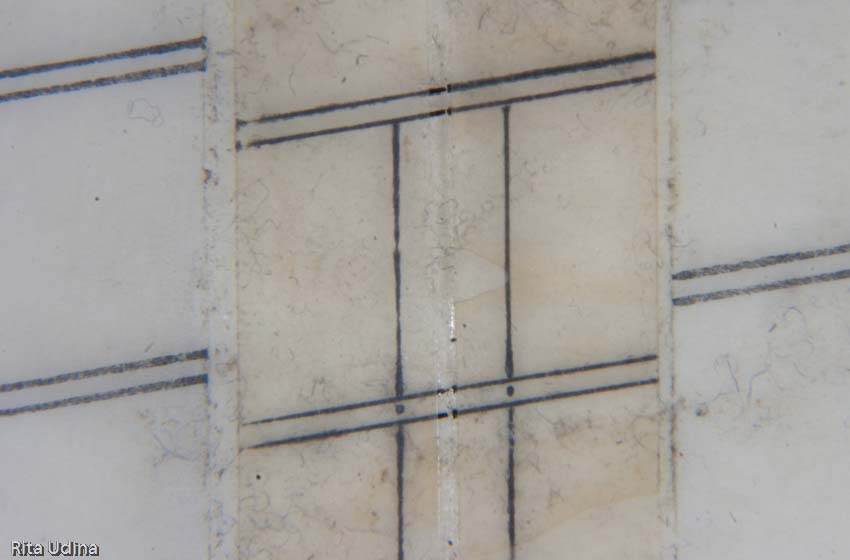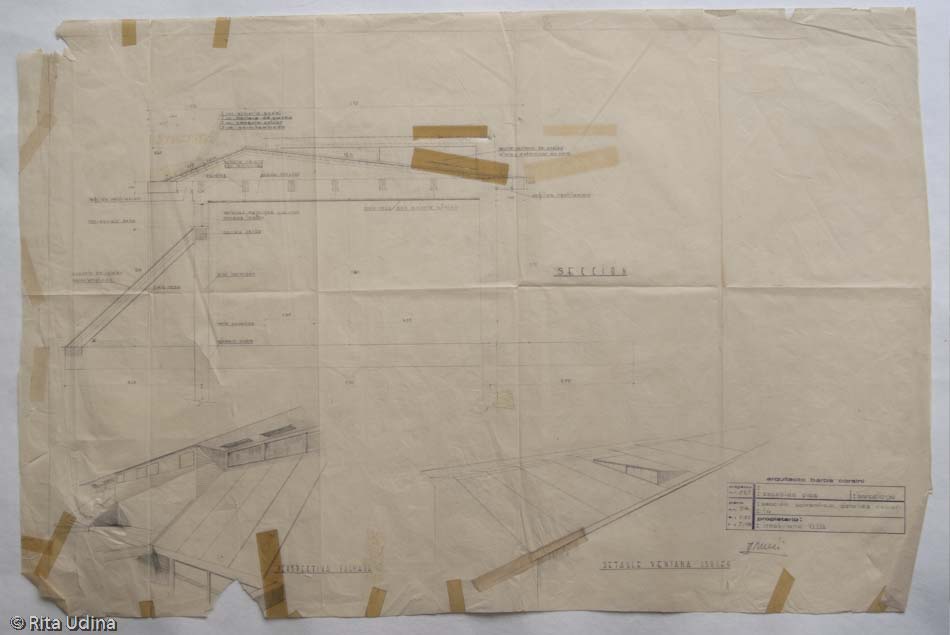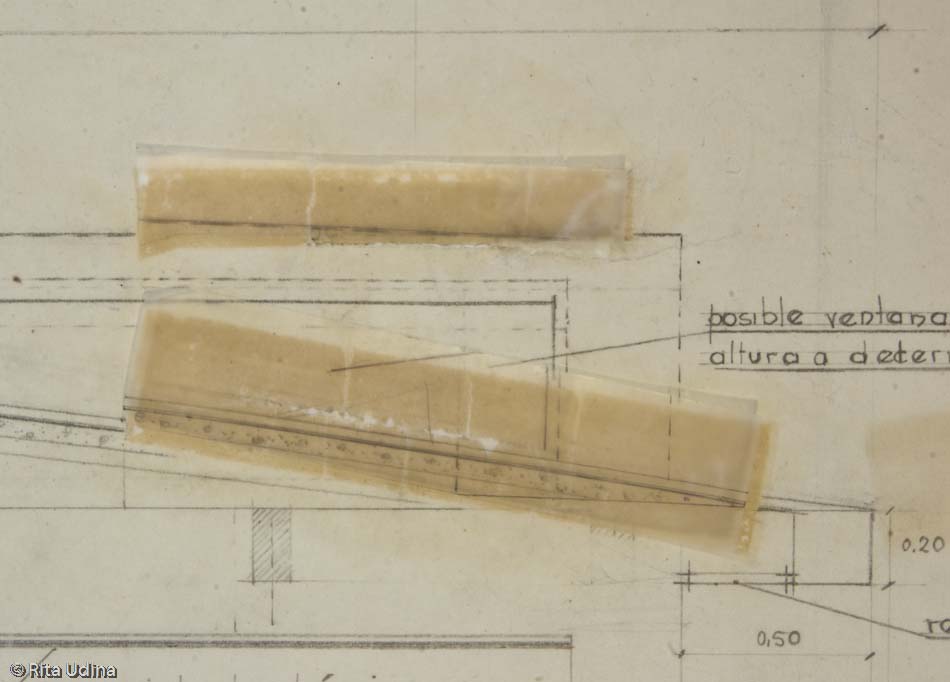Conservation of architectural drawings on tracing paper and onion skin paper with tapes
- Owner: Association of Architects of Catalonia (CoAC).
- Artefact: Architectural drawings on tracing paper and onion skin paper.
- Date: 20th century.
- Damages: Pressure-sensitive tapes, folds on paper, tears, losses, tape stains.
- Conservation treatment: Stain removal, pressure sensitive tapes removal, tear mending, flattening.
- Other links: This conservation treatment has been complex enough to be worth a blog post. Click to know all the details: This document will self-destruct in 30 secs!
Or you might be interested in Pressure sensitive tapes: Degradation mechanisms and removal.
And even a third one: Onion skin paper: History, Uses, Composition and Conservation.
Scroll the white line to compare the before and after treatment images:
Architectural drawing, ink on tracing paper (Meridiana Greyhound Track, by architect Bonet Castellana)


Ink architectural drawing on tracing paper before conservation (top) and after treatment (bottom). The carrier of the tape (the plastic) has been removed and repositioned back, replacing the fatty adhesive by an acrylic one applied by remoistening.
Ink architectural drawing on tracing paper. Meridiana Greyhound Track (Barcelona), by architect Bonet Castellana (c. 1960).


Before conservation (top) the sellotape had slipped and with it the lines on top of it, which did no longer match the neighbouring drawing lines. Dirt was already there before pasting the adhesive carrier… No need for CSI special labs to see that! And yet it is so common that those ones who use these tapes are not the kind of very clean and accurate ones. Look at the plastic strips, which has slipped when the heat melted the fatty adhesive, and plastic has shrank. Watch out: since the drawing lines are on top of the pressure sensitive tape, original to the artwork. Meridiana Greyhound Track (Barcelona), by architect Bonet Castellana (c. 1960).
Pencil architectural drawing on onion skin paper (Pies Schools, by architect Barba Corsini)


Onion skin paper with tapes before (left) and after treatment (right).
During the conservation treatment the plastic tape has been removed and repositioned, replacing the fatty adhesive by an acrylic one applied by remoistening. The fatty adhesive has been removed from the tape and the paper.
Architectural drawing for School “Escoles Pies” made on onion skin paper and graphite pencil by the architect Barba Corsini (c.1960).
The damage cannot be easily split from the drawing since the (evil) tapes carries some of the drawing lines on top of the plastic carrier.
Architectural drawing for School “Escoles Pies” drawn on onion skin paper and graphite pencil by the architect Barba Corsini (c.1960)
Plànol de les Escoles Pies, en paper ceba delineat a llapis de grafit, de l’arquitecte Barba Corsini.
During the conservation treatment the plastic tape has been removed and repositioned, replacing the fatty adhesive by an acrylic one applied by remoistening. The fatty adhesive has been removed from the tape and the paper.
Architectural drawing for School “Escoles Pies” made on onion skin paper and graphite pencil by the architect Barba Corsini (c.1960).


Detail image of the tapes on the drawing before (left) and after conservation treatment (right). The plastic tape carrier has also been restored, removing the fatty adhesive but preserving the plastic tape.
Architectural drawing for School “Escoles Pies” on onion skin paper and graphite pencil by architect Barba Corsini (c.1960).
Open each image individually to read title and caption:
Clients
Types of projects
Conservation of architectural drawings on tracing paper and onion skin paper with tapes
- Owner: Association of Architects of Catalonia (CoAC).
- Artefact: Architectural drawings on tracing paper and onion skin paper.
- Date: 20th century.
- Damages: Pressure-sensitive tapes, folds on paper, tears, losses, tape stains.
- Conservation treatment: Stain removal, pressure sensitive tapes removal, tear mending, flattening.
- Other links: This conservation treatment has been complex enough to be worth a blog post. Click to know all the details: This document will self-destruct in 30 secs!
Or you might be interested in Pressure sensitive tapes: Degradation mechanisms and removal.
And even a third one: Onion skin paper: History, Uses, Composition and Conservation.
Scroll the white line to compare the before and after treatment images:
Architectural drawing, ink on tracing paper (Meridiana Greyhound Track, by architect Bonet Castellana)


Ink architectural drawing on tracing paper before conservation (top) and after treatment (bottom). The carrier of the tape (the plastic) has been removed and repositioned back, replacing the fatty adhesive by an acrylic one applied by remoistening.
Ink architectural drawing on tracing paper. Meridiana Greyhound Track (Barcelona), by architect Bonet Castellana (c. 1960).


Before conservation (top) the sellotape had slipped and with it the lines on top of it, which did no longer match the neighbouring drawing lines. Dirt was already there before pasting the adhesive carrier… No need for CSI special labs to see that! And yet it is so common that those ones who use these tapes are not the kind of very clean and accurate ones. Look at the plastic strips, which has slipped when the heat melted the fatty adhesive, and plastic has shrank. Watch out: since the drawing lines are on top of the pressure sensitive tape, original to the artwork. Meridiana Greyhound Track (Barcelona), by architect Bonet Castellana (c. 1960).
Pencil architectural drawing on onion skin paper (Pies Schools, by architect Barba Corsini)


Onion skin paper with tapes before (left) and after treatment (right).
During the conservation treatment the plastic tape has been removed and repositioned, replacing the fatty adhesive by an acrylic one applied by remoistening. The fatty adhesive has been removed from the tape and the paper.
Architectural drawing for School “Escoles Pies” made on onion skin paper and graphite pencil by the architect Barba Corsini (c.1960).
The damage cannot be easily split from the drawing since the (evil) tapes carries some of the drawing lines on top of the plastic carrier.
Architectural drawing for School “Escoles Pies” drawn on onion skin paper and graphite pencil by the architect Barba Corsini (c.1960)
Plànol de les Escoles Pies, en paper ceba delineat a llapis de grafit, de l’arquitecte Barba Corsini.
During the conservation treatment the plastic tape has been removed and repositioned, replacing the fatty adhesive by an acrylic one applied by remoistening. The fatty adhesive has been removed from the tape and the paper.
Architectural drawing for School “Escoles Pies” made on onion skin paper and graphite pencil by the architect Barba Corsini (c.1960).


Detail image of the tapes on the drawing before (left) and after conservation treatment (right). The plastic tape carrier has also been restored, removing the fatty adhesive but preserving the plastic tape.
Architectural drawing for School “Escoles Pies” on onion skin paper and graphite pencil by architect Barba Corsini (c.1960).
Open each image individually to read title and caption:



